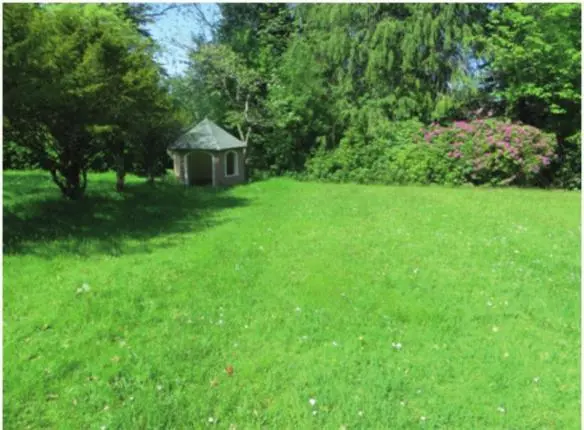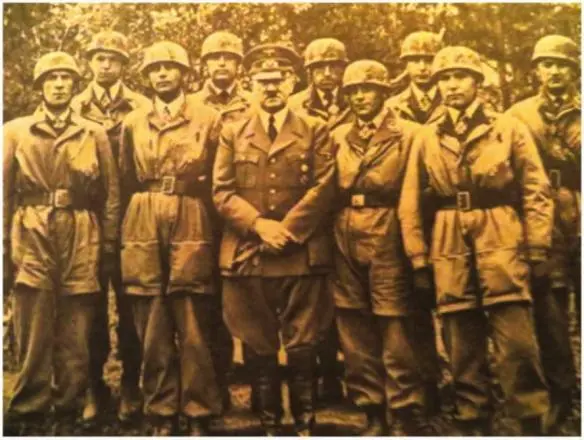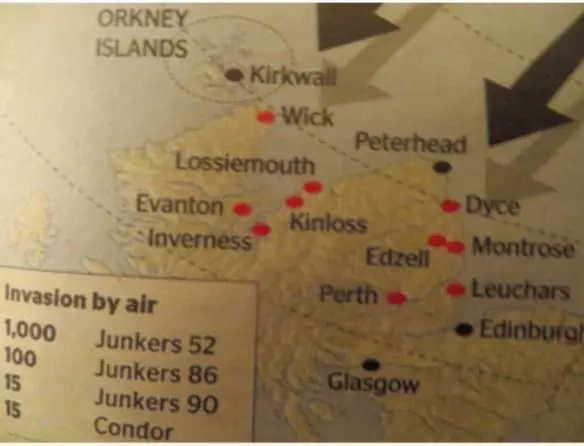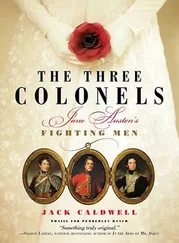
This is the gazebo in the hotel’s grounds where Hilda received instructions as well as the Delphin 7 short-wave radio.

The German Eagle Silver Civilian Medal with crossed swords was established in 1937 for notable German nationals and foreigners. This medal was awarded to Hilda Richter for her espionage services to the Third Reich and medical services rendered by her late husband to Reinhardt Heydrich’s family.

Hilda’s oboe
Hitler’s plans to invade northern Scotland in 1940
Previously classified files, which have been unseen for 75 years, were released on 1 stJanuary 2016. They reveal that the war cabinet became convinced that a Nazi invasion of northern Scotland was imminent. ( A Reluctant Spy was still to be edited in November the previous year when the author was unaware of this classified document. The enemy’s need for information about the north of Scotland’s air bases and troop movements was crucial, and Hilda was at the centre of this espionage.)
The threat of invasion only receded after the Royal Air Force regained air superiority following the Battle of Britain between June and October of that year. In August, British commanders were still uncertain how Hitler’s armies were planning to invade the UK from occupied continental Europe. One document brought to the attention of General Alan Brooke the Commander-in-Chief of Home Forces was entitled German airborne landings in northern Scotland with a view to the neutralization of fleet bases as a preliminary to the invasion of England .
The document from August 6th 1940 claimed that there was every chance that the Germans ‘could land in Scotland 20,500 airborne troops during the first three days for the purpose of capturing and holding all aerodromes north of the river Tay.’ It further stated that ‘they could reinforce these troops by approximately 900 men per day, bringing the total number of airborne troops landed during the first week of the operation to 24,000.’
This file which was recently opened and placed in the National Archives at Kew, London, warned that: ‘enemy forces could capture RAF airfields at Dyce, Inverness, Perth, Lossiemouth, Leuchars, Kinloss, Montrose, Evanton as well as a further six bases on Orkney and Shetland. It was further thought that 440 parachutists could be landed round the outskirts of each of the aerodromes in some cases after a preliminary bombardment. Losses before landing would not exceed 20%. After releasing their parachutists, transport aircraft would return to bases in Norway, Denmark and Holland to refuel and reload.’
One entry, which demonstrates how serious a prospect of invasion was being taken, states: ‘An attack may come at any moment. The most dangerous time is from now until the end of September.’
The briefings were drawn up at a time when Britain was isolated and vulnerable. The Germans had just completed the occupation of Norway and the Channel Islands. Nazi troops had reached Paris and the battle of Britain was underway.
General Alan Brooke adopted a pessimistic view on whether an invasion of Scotland and the Northern Isles could and should be repelled. He wrote: ‘It is not possible to send and maintain in the islands a garrison which would be proof against a large-scale air and sea-borne operation, and I have told the commander-in-chief, Scottish Command, that he is to make it a primary objective to secure and hold the port of Lerwick, without which the enemy would also find it difficult to maintain himself. The moral and psychological effect of a German occupation of the islands which are separated by so short a distance from our main fleet anchorage would be most unfortunate.’
General Brooke concluded: ‘As regards the rest of Scotland, I have only a certain number of troops and I consider it preferable to maintain preponderance in East Anglia and the Home Counties for the defence of London.’
Had General Brooke maintained this stance, Germany could have invaded Scotland successfully and in a short time occupied the whole of Britain.

Photo by courtesy of Marc Horne of the Times .
Hitler congratulates German paratroopers after the capture of a key Belgian fort in 1940. Fears that Scottish air bases were next on the Nazi list were taken seriously. General Alan Brooke said that he did not have troops to defend them.

Photo by courtesy of Marc Horne of the Times .
Hitler’s plans to invade Scotland in 1940 would involve 1,000 Junkers 52; 100 Junkers 86; 15 Junkers 90 and 15 Condor planes all flying from air bases in occupied countries and particularly from nearby occupied Norway.
First, my thanks go my godmother Vera Wild (née Caldwell, 1900-1994) who told me Hilda’s story when she was 92 years old. Then grateful thanks are due to my late uncle, Dr A. Stanley Caldwell, a former medical officer of health for the Kingdom of Fife who provided me with the letter and stamps belonging to Aunty Hilda Campbell. Stanley also told me about Hilda’s life and travels around the north of Scotland in 1938 to locate air bases. He met and corresponded with her several times until her death. I am also indebted to my mother-in-law, G. Shirley France, who served in the Wrens at Bletchley Park during the final two years of the Second World War. Many died never having divulged what they did at Bletchley during World War 2. Much gratitude goes to Marc Horne, the Times journalist, who permitted me to reprint Hitler’s plans for invading Scotland in 1940. To film executive Mathilde Vuillermoz I am especially grateful and in whose hands I await developments.
Miller Caldwell is a Scottish-based writer of novels.
He graduated from London University, having studied African industrial development, traditional African religions and the colonial history of West Africa. He has had articles published in health magazines and The Scottish Review .
Following a life of humanitarian work in Ghana, Pakistan and Scotland, he has gained remarkable insights into human nature. He brought an African president to tears in West Africa in 2000, and he confronted Osama bin Laden near Abbottabad, in the NWFP of the Islamic State of Pakistan in 2006. He was, for ten years, the local chair of the Scottish Association for the Study of Offending. He also served on the committee of the Society of Authors in Scotland as its events manager.
Miller plays a variety of brass, woodwind and keyboard instruments, which provide a break from writing. Married, he has two daughters and lives in Dumfries, in southwest Scotland.
Other books by Miller Caldwell
Novels:
Operation Oboe
A Scottish widow becomes a Second World War spy in West Africa
ISBN 0755200090-X New Generation Publishers
The Last Shepherd
An arrogant city banker clashes with the rural ways of the Last Shepherd, in south-west Scotland.
Читать дальше

















